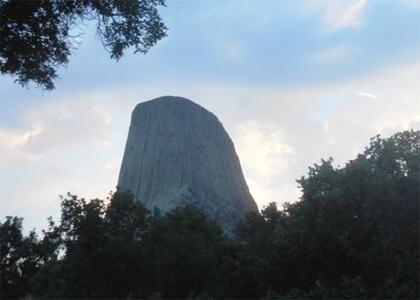This summer I worked as a biological technician. Now what that entails is a tricky question and an even more difficult answer. As part of the resource team at Devils Tower National Monument, I monitored wildlife, managed exotic invasive plant species and maintained the resources of the park. Devils Tower is a looming column of stone that creates its own thermals. This attracts various types of birds, including the endangered prairie falcon. During nesting season there is a nesting closure to allow the falcons to nest on the tower relatively undisturbed. With binoculars we would search for the nests and record any sightings. Another animal we monitored weekly was prairie dogs. Prairie dogs are a controversial issue in the West. Ranchers and farmers consider them a pest, as their holes create hazards for cattle and sheep. In addition, there is direct competition between the prairie dogs and the cattle for grass. As a result the settlers tried to wipe out the prairie dogs when they first developed the land. Though they did not succeed, prairie dogs occupy about 2 % of their former range, earning them a threatened status; however, the population of prairie dogs at Devils Tower is expanding. We would stand with binoculars on the West side of the prairie dog town and count the dogs we could see above ground in a 180-degree sweep. Then we would travel halfway through prairie dog town and repeat the process. By traveling to the East side of prairie dog town and the picnic and statue area, we would have a rough estimate of the prairie dog population. Depending on the time of day and weather, the counts would vary.
We also managed the wildlife at the Tower. A skunk family wandered around the entrance station during daylight hours. We set up traps baited with salmon cat food and a few weeks later there were two skunks in the traps (and a raccoon). The skunks were then transported very carefully to a less habituated area of the monument and released. Luckily, no one got sprayed! A tip to get rid of tailgaters: have a skunk in the bed of your trunk and if they get too close they will receive a whiff. There will be more distance between you and the tailgater in a few seconds! In addition to skunks, we also managed the prairie dogs. In efforts to exterminate the prairie dogs, the settlers had endangered its predator, the black-footed ferret. Hawks and badgers eat only a small percent of the prairie dogs. The
majority of the dead prairie dogs I saw while there had been killed by traffic. With few predators, the prairie dogs are expanding to greener pastures, such as the picnic area. To discourage them, we filled in their holes, set up traps, and as a last resort, gassed them. The prairie dogs we did manage to capture were relocated to another part of town. Prairie dogs, which are actually rodents, are highly social animals. They live in a huge “town”, which consists of acre territories where different families live. If a prairie dog from a different part of town wandered into another family’s territory, they would defend it to the death.
A major part of the work we did was invasive plant management. We would scout an area and put on 35-pound backpack sprayers (if you filled up to 3 gallons) composed of a mixture of chemicals, water and dye. Armed and dangerous to plants, we spread out in a grid pattern to get as many of them as we could. Common mullein, bull thistle, musk thistle, sweet clover, penny crest, scotch thistle and houndstounge were the targets. Later in the season we expanded our arsenal to machetes to cut off the seed heads of the mullein and thistles. Over all we treated 214 acres through mechanical and spray treatments. Some days we sprayed until noon, till it got too hot out that it became dangerous to spray. Other days we were unable to spray because of the severe weather warnings. Some days were tougher than others but maintaining a positive attitude through it all helped make the job easier.
Another aspect of our job was maintaining the parks resources. From a distance the Portable Ozone Monitoring System (P.O.M.S) looks like space ship with the solar panels sticking out and the antennae pointing to the sky. This monitoring station collects data on the atmosphere, which is then analyzed to assess the condition of the local atmosphere. P.O.M.S needed the data logger to be replaced and shipped to be analyzed almost weekly. Parts would sometimes need to be replaced. Other jobs we did included cutting down trees that blocked trails and investigating reports of mountain lion sightings. Take advantage of the opportunities presented and don’t be afraid to ask questions. As a side project I created a guide for collecting seeds from native plants and started to compile some seeds for a seed bank. These seeds will be planted to compete with the invasive species and help maintain the native plants in the park. While I was there I was also trained to fight wildland fires and drive a UTV (utility task vehicle). I participated in Search and Rescue Training, and learned to climb and shoot. Don’t be afraid to learn and try new activities!

July 18, 2013